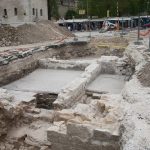After their first scarce statements upon the discovery of the site caused a media frenzy, Conservation department in Split finally speaks up about their findings in a press release.
As we previously reported, a lot of stir was caused by the decision made by the City of Split to fill the newly found archaeological site in order to build a new taxi stand and bus roundabout. Much of it was caused by very scarce information given to the press by the members of the Conservation department. On April 22, 2016, director of the Conservation department in Split, dr. sc. Radoslav Bužančić finally decided to explain the findings and reassure the public with a press release.
Here it is in full.
„Rescue archaeological research conducted on the eastern coast of Split have been in the media spotlight during the last few days. Headlines, inexpert interpretation of our findings and comments made by the press and residents have completely changed the content and significance of the discovered remains. In the probes excavated in the locality of former lazarette, there are no remains of ancient architecture. Walls that were found are from the new age, oldest ones date back to the 16th and 17th century and they belong to the city walls which were used to defend the lazaretto. Furthermore, photographs of floors which were published on various portals and in various media are new and belong to the former St. Rocco prison which was demolished in the bombing in 1943. News of ancient findings relates to several stone blocks from the Roman times and one of them was an older Hellenistic bunjato block and they were all built into the new age architecture. Their significance is of forensic nature because they are a testimony of early layers of the city which, sadly, were not found in this particular location.
As opposed to what was written in the media, the Conservation department asked a while ago for the preliminary design to be changed in order to form an archaeological park west of the Tourist palace instead of the planned cafe and restaurant terraces. The project presented our findings of the south walls with a late renaissance fort stretching 30 metres in length from the Tourist palace to the road. The foundations of this fortress were built from the ancient blocks of the demolished walls of Diocletian’s palace.
Worried protectors of Split historical heritage don’t have to fear whether the experts are neglecting to present these archaeological findings, there’s no reason for it since only 4 metres of found foundations of the southern fortification will not be presented after our research in order to ensure normal traffic flow in the east coast. They all have to realise that the presentation of historical layers is a very complex task which shouldn’t, in any way, imperil universal values of Split, the rhythm of everyday life being one of those values. Presentation of the south fortification wall in the archaeological park, which will be accompanies by graphic and textual explanations and displayed stone decorations, is a huge step in the complex presentation of Split’s heritage, not devastation as some undiscerning critics would have us all think.
As far as the Split lazaretto is concerned, it was built at the turn of the 16th century south-east of Diocletian’s palace and they were demolished during WWII. Their removal was requested as early as the end of the 19th century in order to get the view of the Palace walls. Bombing which demolished them ended a time-old discussion on whether they should be removed and enabled the presentation of the south and east walls of Diocletian’s Palace.“








